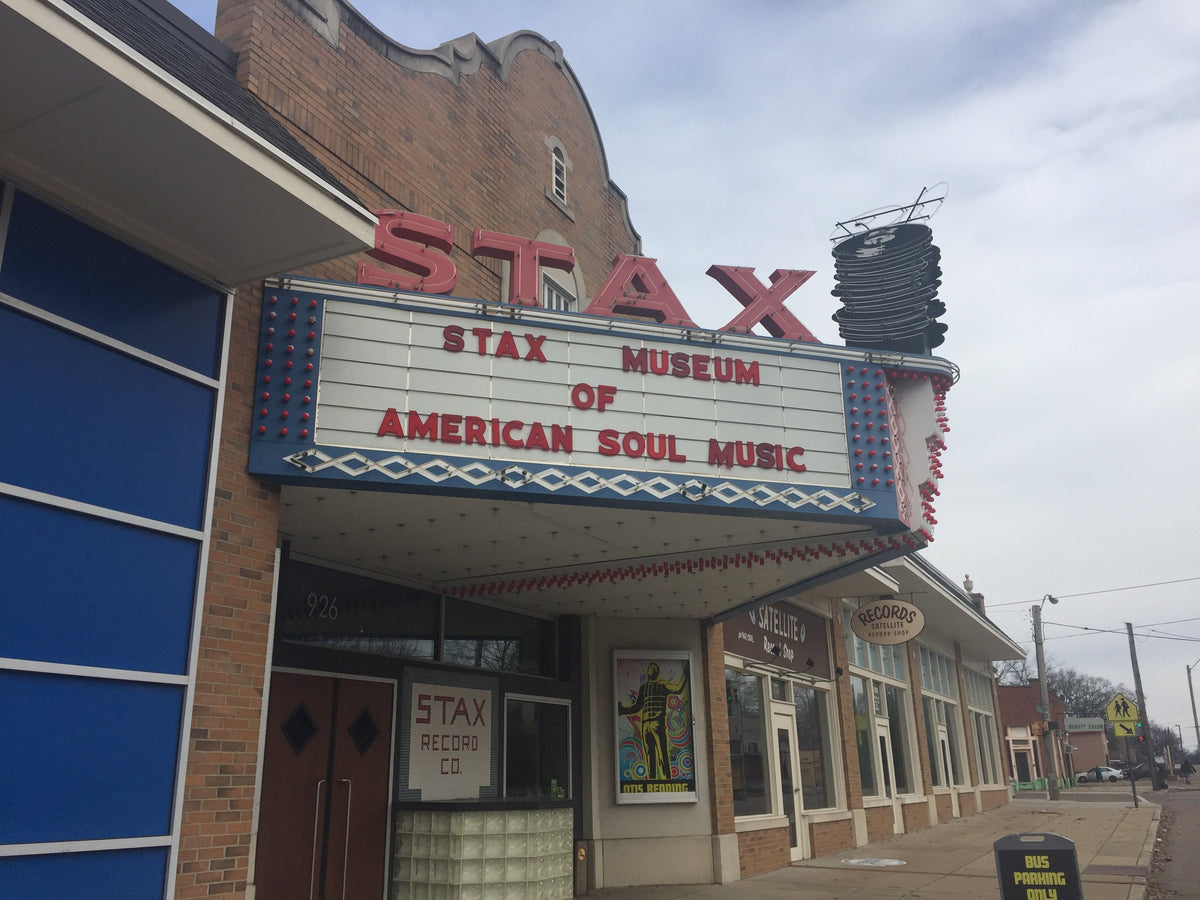Darrell Banks’ ‘Here To Stay’ Almost Unified Soul Music
Read An Excerpt From The Liner Notes For June’s Classics Album
In June, members of our Classics subscription will receive Here To Stay, the second album from Detroit soul singer Darrell Banks. Banks was a one-semi-hit wonder who was killed by a policeman less than a year after Here To Stay was released, and before Banks’ talents had been fully realized on wax. This new edition of the album is remastered from original analog tapes by Paul Blakemore, and features a Listening Notes Booklet by our own Andrew Winistorfer.
Below, you can read an excerpt from the Listening Notes booklet, and learn how Banks was a bridge between Detroit and Memphis soul.
There it was, in the March 12, 1970, edition of Jet magazine, buried underneath a story about Stevie Wonder’s upcoming wedding, and above a story about Sly Stone cancelling a bunch of concerts.
Singer Darrell Banks Killed In Detroit Tiff
Stax Records’ artists Darrell Banks, 35, was shot to death in Detroit in an altercation with an off-duty policeman over a woman, according to the officer, Aaron Bullock. Banks, whose tune, “Walk Right On In,” was a hit a few years ago, reportedly was waiting in front of Marjorie Bozeman’s home when Bullock and Miss Bozeman, 30, with whom Banks allegedly had been keeping company and from whom he was estranged, drove up. According to Bullock, Banks pulled a .22 caliber revolver and Bullock ducked, shooting the singer in the left base of the neck. Banks was dead on arrival at New Grace Hospital.
It took 16 days for Darrell Banks’ shooting to make the national news. It reached Detroit local media only slightly earlier; Detroit’s black newspaper, the Detroit Chronicle, carried the news on their front page on March 7. Even with the added time, both stories had some of the smaller details wrong—Banks was only 32, and the song, though originally titled “Walk Right On In” and featuring that phrase in the chorus, was actually “Open The Door To Your Heart”—but they got the general story right: A promising soul singer, less than a year removed from his sophomore album, was shot dead by a policeman.
The details of that morning in Detroit are forever between Bullock, Bozeman, and Banks, but the general outline is that Banks—a man whose best songs, ironically, were about feeling heartbroken and acting irrationally—found out Bozeman was now seeing Bullock instead of him. He saw them together in front of her house, approached her angrily, Bullock interceded on her behalf, Banks pulled a gun, and ended up dead. Like most women in domestic disputes at the time, Bozeman’s side of the story was unfortunately never told—though The Encyclopedia of Dead Rock Stars by Jeremy Simmonds claims she was only seeing Bullock that day to break it off with him in order to be with Banks—and since Banks allegedly drew first, Bullock never faced charges or had his statement entered into the public record.
Because of the shooting, Banks’ career is unfortunately short; his recording output lasted less than four years, his impact in the sands around the legs of history limited to fewer than 10 45s, and two LP’s. According to Google, his life can be reduced to but two factoids: he was shot and killed, and a 1-of-1 pressing of “Open The Door To Your Heart” was sold for an insane £14,453 (more than $23,000) in 2014.
But Banks’ legacy is much more vast than those talking points that might win you a music trivia game someday in the future: Here to Stay is a Nexus point—and arguably the Nexus point—in the conversation between the Memphis soul sound of Stax Records (which released this album via its Volt imprint) and the more polished, pop-oriented Detroit soul sound, as epitomized by Motown. Banks was a vessel for Stax to try to make albums that would appeal to people buying thousands of Marvin Gaye and Diana Ross records, a performer who could, with his gravely, powder-keg voice—along with authentic Detroit musicians and production, recorded in Detroit—bridge the gap between the then preeminent modes for soul music, and bring Stax more of the mainstream commercial success experienced by Motown. Banks never accomplished that feat, and neither did Stax, for that matter. But Here To Stay got close.
Banks’ biography is incomplete, owing to the fact that he never once sat for a reporter’s interview; even Stax’s in-house promotional magazine, archived at the Stax Museum in Memphis, never covered him. But these details are as confirmable as confirmable goes: He was born on July 25, 1937, in Mansfield, Ohio. During his childhood, his family moved to Buffalo, New York, where he was raised. At some point between his birth and 1966, when “Open The Door To Your Heart” came out, he got some amount of notoriety while performing in nightclubs around Buffalo. One of them was Club Revilot, and Banks was such a popular draw, the nightclub owner became his manager. That manager, upon hearing some Detroit upstarts had wanted to launch a label, let them use his club as their name (Revilot Records) and forwarded Banks on to them as a possible recording artist. One of those upstarts was Don Davis, who had started Revilot Records with some other Detroit music businessmen as the in-house producer.
Banks was signed as Revilot’s first artist, though he wouldn’t become their most famous; the label also signed the Parliaments, the first band from George Clinton, who’d later get infamy as the ringleader of Parliament-Funkadelic. When it came time for Banks to cut a 45, he suggested a song he claimed to have written himself. It was called “Open The Door To Your Heart” and Banks hadn’t written it at all; he had stolen it from his friend, a singer named Donnie Elbert, and the only change Banks made from Elbert’s original was speeding up the tempo and changing the title (from “Walk Right On In”). The original run of the Revilot 45 would not list Elbert as a songwriter, though after the song took off, and after a court proceeding, he got his credit on subsequent reissues. Which was a good thing for Elbert; “Open The Door To Your Heart” became a surprise smash, one of the only non-Motown R&B records made in Detroit to challenge Motown songs on the charts. “Open” went to No. 2 on the Billboard R&B chart, and was only blocked from No. 1 by the Temptations’ “Ain’t Too Proud To Beg.”
Banks put out only one more single on Revilot before his contract was flipped to Atco, one of the smaller labels under the Atlantic umbrella, for him to make his debut LP. Banks recorded Darrell Banks Is Here in 1967, which was released quickly that year to try to capitalize on his single success. The album featured his Revilot singles—still some of the best raw R&B from the period—and a smattering of covers.
Despite the chart success of “Open,” Darrell Banks Is Here sold disappointingly, and Atco moved on and Banks was set adrift. That is, until his old friend Don Davis came calling as the head of A&R for Stax.
By the time Banks came to Stax—and more specifically, their Volt imprint, which was also Otis Redding’s home on the label—Davis had embarked on his mission to make albums that were loyal to the Stax sound, but also with the—as Peter Guralnick’s Sweet Soul Music puts it—“professionalism” of Motown. Davis set Banks to working on sessions that would yield a total of 16 songs; that number accounts for more than half of Banks’ recorded output in his entire career. 11 songs eventually made it to the retroactively tragically titled Here To Stay, with five more remaining in demo stage, not seeing release until 2013’s Kent Soul compilation, I’m The One Who Loves You—The Volt Recordings.
Here To Stay is a masterpiece of form, a practically perfect album. It showcases Banks’ talents in a way that his debut did not; even though he was a bit older than some soul singers when they made their second album, it sounds like he’s just gaining full mastery of his voice. The album opens with one of the sweetest notes he ever hit, and as the song, “Just Because Your Love Is Gone,” progresses through its tale of woe, he gets increasingly desperate, every “whoa baby” becoming longer, more strained, more pained. His pleas for forgiveness on “Forgive Me” regress to raw and howling, hitting a grittiness that you don’t hear on many soul records with a strings section behind it. But he could also hit conversational tones on tracks like “We’ll Get Over” and “Never Alone,” and buried every other singer that has ever sang “When A Man Loves A Woman” just for his sheer power.
Don Davis, in addition to producing the album, wrote or co-wrote three songs here, but the ultimate peak is Here To Stay’s second track, “Forgive Me,” a song that is as close as Stax ever got to being Motown. There’s the hallmark layered orchestration, the drum beat that is made to sound incredible coming out of a transistor radio, and that lightly funky guitar riff. On top of it all is Banks, with his revving motorcycle of a voice, winding up and out over the chorus, delivering on all the promise contained between his two vocal chords. It’s the song that hits the perfect ideal that Al Bell had when he hired Davis; it’s a melding of Stax hallmarks with a cleaner, more professional sound. It was never released as a single.
Here To Stay underperformed after its release. Stax released three singles from Here To Stay in 1969 to try to help the LP get some traction, but there was hardly any chart pickup of the album. A couple months later, Banks was shot, so there’s no way of knowing what his next move was; he had made one amazing LP for Volt, but who knows if he’d have been given the chance to make another one.
Banks was buried in Detroit Memorial Park Cemetery on March 2, 1970. There was a benefit for his family later that night that featured performances from Martha Reeves of the Vandellas. Banks was buried—as most of the people at Detroit Memorial Park were in those days—in an unmarked grave. It’d remain that way until 2004, when members of the Soulful Detroit online forum got together and put a special bench on Banks’ burial plot.
Here To Stay has been out of print on vinyl in the U.S. since its release 49 years ago. It remains an album of promise ultimately unfulfilled, of both Banks’ and a soul music that made room for the opposing ideologies of Stax and Motown.
Andrew Winistorfer is Senior Director of Music and Editorial at Vinyl Me, Please, and a writer and editor of their books, 100 Albums You Need in Your Collection and The Best Record Stores in the United States. He’s written Listening Notes for more than 30 VMP releases, co-produced multiple VMP Anthologies, and executive produced the VMP Anthologies The Story of Vanguard, The Story of Willie Nelson, Miles Davis: The Electric Years and The Story of Waylon Jennings. He lives in Saint Paul, Minnesota.
Related Articles
Join the Club!
Join Now, Starting at $36Pages







